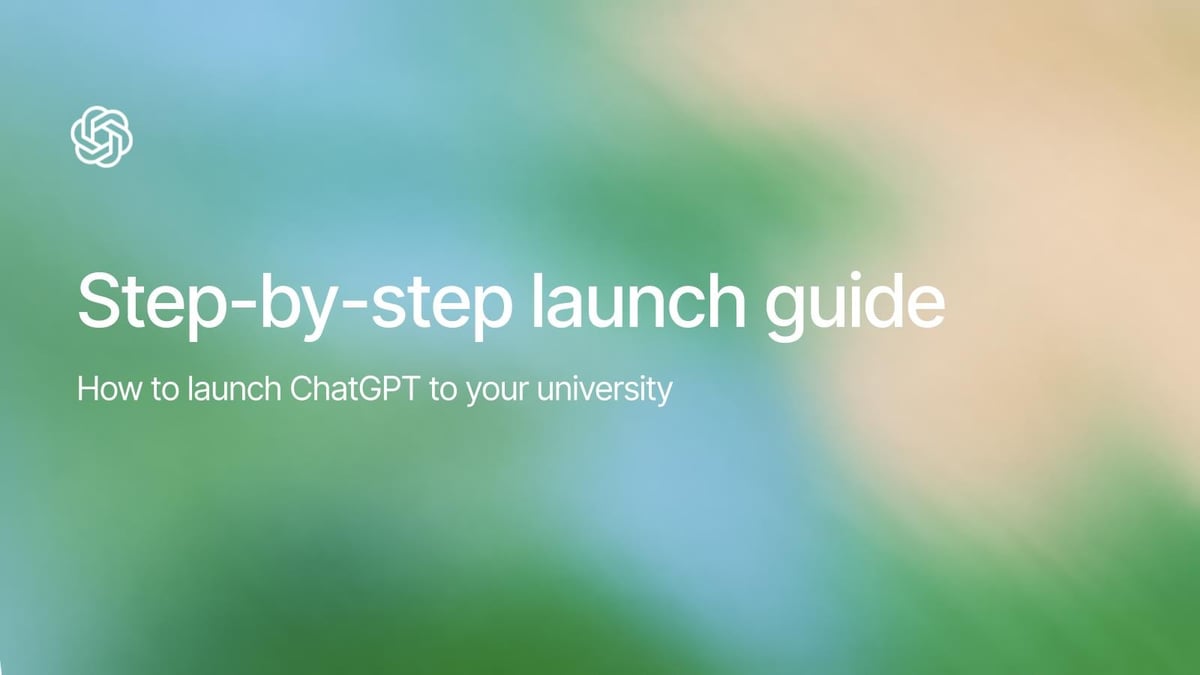Article
August 22, 2025 · Last updated on August 27, 2025
ChatGPT Edu Launch Guide for Higher Ed Universities

# Higher Education
A clear, actionable roadmap to help you launch ChatGPT Edu at your university, from planning to full implementation.

Kirk Gulezian

ChatGPT Edu Launch Guide for Higher Ed Universities
A clear, actionable roadmap to help you launch ChatGPT Edu at your university, from planning to full implementation.
Likely Stakeholders Involved in a Launch
To execute a successful rollout, you will likely need representatives from the following roles:
Executive Sponsors – Senior leadership to provide vision, funding, and endorsement.
Project Lead – Overall owner accountable for execution.
IT & Security – Configure authentication, manage access, provide technical support.
Communications/Marketing – Manage announcements, messaging, and awareness.
Policy & Compliance – Ensure responsible use, review legal/privacy requirements.
End-User Representatives (Champions) – Early adopters and advocates who represent the broader user base (e.g., instructional staff, administrative staff, or learners, depending on rollout scope).
Support Staff – Help desk or frontline IT staff for day-to-day support.
1. Strategic Foundations
Roles Involved: Executive Sponsors, Project Lead, Policy & Compliance, Communications
Goal: Establish clarity, ownership, and governance before launch.
Executive Alignment
- Host a briefing with key decision-makers (e.g., leadership, IT leadership, program owners) to align on priorities.
- Define a small set of measurable outcomes, such as adoption or time saved.
- Confirm scope, funding, and visible executive endorsement to ensure organizational commitment.
Governance & Compliance
- Develop an AI Use Policy: Draft a clear, one-page policy outlining permitted and prohibited uses. Review publicly available policies from peer institutions to inform your approach.
- Secure Legal and Compliance Approval: Obtain sign-off from legal and compliance teams to ensure alignment with institutional standards.
- Establish Oversight: Form a governance group responsible for monitoring use, reviewing cases, and handling escalations.
- Define Escalation Protocols: Document clear steps for addressing potential misuse or policy violations (ex: If a student misuses ChatGPT to plagiarize, who handles this?)
Project Team Setup
- Appoint a Project Lead: Designate a Project Lead with clear authority to make decisions and drive implementation forward.
- Form a Cross-Functional Team: Assemble representatives from IT, communications, and stakeholder groups to ensure broad alignment.
- Establish a Shared Tracker: Create a centralized tracker to manage tasks, deadlines, and responsibilities.
Getting Oriented
- Build a Common Foundation: Ask stakeholders to watch ChatGPT 101 to gain a baseline understanding of ChatGPT Edu’s features and capabilities.
- Leverage Peer Resources: Encourage sign-up for OpenAI Academy and participation in the Higher Education community to connect with peers and access curated resources.
- Develop an Internal Communications Plan: Create a plan with clear announcements, FAQs, and talking points tailored to different audiences. Use OpenAI's AI Communication Toolkit as inspiration.
- Ensure messaging emphasizes why the institution is adopting AI and proactively addresses common questions.
2. Technical Enablement
Roles Involved: IT & Security, Project Lead, Support Staff
Goal: Build a secure, scalable technical foundation.
Access & Authentication
- Review Workspace Configuration: Begin by understanding and selecting the appropriate workspace settings to align with your institution’s governance and access requirements.
- Evaluate Single Sign-On (SSO) Options Familiarize yourself with the available SSO options across OpenAI services to determine which approach best supports your security and user experience needs.
- Understand Roles and Permissions: Review the different roles within ChatGPT to clarify how administrators, faculty, staff, and students will interact with the platform.
- Define a User Management Strategy: Establish a clear approach to user management, including how accounts will be provisioned, maintained, and deactivated over time.
- Set Up Single Sign-On (SSO) and Domain Verification Configure SSO and complete domain verification to ensure that only authorized users within your institution can access the platform.
- Prove Domain Ownership: Add TXT records to your DNS to validate institutional ownership of the domain.
- Integrate with Identity Providers: Configure SAML or OIDC with your institution’s identity provider to enable secure authentication flows.
- Test Authentication Flows: Conduct a pilot test with a small administrative group to validate login processes and identify any adjustments before broad rollout.
- (Optional - Advanced) Role-Based Access Control (RBAC): Configure RBAC to manage permissions based on user groups. RBAC can be implemented independently or in combination with SCIM for greater automation.
- (Optional - Advanced) SCIM Integration: Enable SCIM integration to automate user provisioning and deprovisioning based on HR or student information systems.
- Synchronize account creation and removal directly from institutional systems
- Map roles (e.g., faculty, students, staff) to appropriate access groups to enforce role-based access controls.
Infrastructure Readiness
- Update Support Systems: Add a dedicated ChatGPT Edu category to your help desk or ticketing platform to streamline support requests.
- Provide a Troubleshooting Guide: Publish a guide with common issues and solutions to reduce support load and enable self-service.
- Set Up Monitoring: Define success metrics and monitor adoption using your analytics tools or available in-product analytics in ChatGPT Edu.
3. Communications & Change Management
Roles Involved: Communications/Marketing, Executive Sponsors, Project Lead
Goal: Build awareness, trust, and enthusiasm across the institution.
Communications Plan
- Finalize tailored launch announcement emails for each stakeholder group.
- Publish a centralized intranet page with FAQs, policies, and resources.
- Host an introductory webinar for all users (and record for on-demand access).
- Translate or localize key materials if needed.
Engagement Channels
- Launch a Resource Hub with training materials, policies, and use cases.
- Create a dedicated feedback loop (e.g., Slack/Teams channel, form, or inbox).
- Offer weekly office hours or drop-in sessions for Q&A.
Messaging Framework
- Position ChatGPT Edu as a supportive tool that enhances productivity, learning, and creativity.
- Provide leaders with talking points and templates to reinforce adoption in their own communications.
- Ensure all messaging clearly addresses “why we’re adopting AI” and answers anticipated FAQs.
4. Training & Enablement
Roles Involved: Project Lead, End-User Representatives (Champions), Communications, IT & Support Staff
Goal: Equip faculty, staff, and students with the knowledge, resources, and confidence to integrate ChatGPT Edu into their daily work and learning.
Role-Based Live Training Sessions:
- Identify priority user groups (e.g., instructional staff, administrative staff, learners)
- Offer short role-specific sessions focused on practical use.
- Record and publish all training sessions in the Resource Hub for on-demand access.
Resource Hub
- Provide role-specific prompt packs (ready-made examples of how to use ChatGPT for tasks like grading or course prep) tailored to faculty, staff, and student needs.
- Offer quick video tutorials (<5 minutes) to address common workflows and frequently asked questions.
- Maintain an evergreen library of guides, best practices, policy documents, and exemplar use cases.
User Onboarding
- Distribute a simple onboarding checklist to new users (e.g., login, introductory video, review policy, try three starter prompts).
- Monitor completion rates and follow up with targeted outreach to ensure all users are successfully onboarded.
Additional Resources
- Share OpenAI Forum talks so users can learn directly from education leaders already adopting AI at scale.
- Offer advanced training opportunities, such as OpenAI Presents: Build Advanced GPTs & Custom Actions, to support power users, innovators, and faculty champions.
Best Practice: Pair early training with visible success stories from faculty or staff to build momentum. Institutions that highlight real-world impact—such as time saved on administrative tasks or innovative classroom applications—see faster adoption and greater confidence in AI use across the community .
5. Pilot & Use Case Development
Roles Involved: Project Lead, IT & Security, End-User Representatives (Champions), Policy & Compliance
Goal: Validate adoption, refine workflows, and showcase impact.
Pilot Setup
- Run a small, time-boxed pilot with an initial cohort and clear success criteria.
- Assign someone to coordinate logistics and collect feedback.
- Invite an initial cohort of early users and leverage their feedback to refine onboarding, training, and support processes before wider rollout.
Use Case Development
- Identify 3–5 participants to develop tangible outputs with ChatGPT Edu (e.g., a policy draft, study guide, or research summary).
- Document each case clearly with step-by-step instructions, screenshots, and lessons learned.
- Publish short case studies for each deliverable, showcasing value and enabling replication across departments.
Feedback Collection
- Use lightweight surveys and periodic small-group conversations to gather insights.
- Track support tickets and recurring issues to identify gaps in training, documentation, or product usability.
6. Full Rollout
Roles Involved: Project Lead, Communications, IT & Support Staff, Executive Sponsors
Goal: Scale access institution-wide in a structured and sustainable way.
Phased Expansion
- Roll out access in manageable waves to ensure smooth adoption.
- Provide each new group with a kickoff email, training link, onboarding checklist, and policy reminders to establish consistency from the start.
Engagement Campaigns
- Host a campus-wide launch event or virtual showcase to mark the transition from pilot to institution-wide adoption.
- Share success stories from the pilot phase to build credibility and momentum across departments.
- Introduce recognition programs for early adopters (e.g., “AI Innovators” spotlight) to encourage champions and peer-to-peer advocacy.
- Invite champions to the OpenAI Forum to connect with the broader educator community.
Support Scaling
- Expand Tier 1 support capacity by training additional staff to handle common questions and troubleshooting.
- Share a short list of common issues and resolutions based on your environment.
- Maintain clear escalation paths to vendor or institutional expert support for more complex issues.
Best Practice: Pair rollout with a steady cadence of updates—highlight adoption metrics, share examples of high-value use cases, and spotlight departmental champions. Institutions that celebrate progress and communicate impact consistently are more successful in sustaining long-term engagement.
Looking Ahead: Building an AI-Ready Institution
As your institution continues to adopt ChatGPT Edu, plan for ongoing improvement rather than treating the launch as a one-time event. Collect feedback from faculty, staff, and students, and use those insights to refine your training and communications over time. Regularly review how ChatGPT Edu is being used, highlight successful practices, and update your resources to keep them relevant.
Encourage champions across departments to share their stories, and create opportunities for peers to learn from each other. By making updates part of your normal academic cycle, you’ll help ensure that ChatGPT Edu continues to deliver value and adapt to the evolving needs of your community.
Useful resources for continued learning with ChatGPT Edu
ChatGPT Edu Video Resources:
How are other universities leveraging AI?
Building an AI-Powered University, featuring University of Maryland, University of Nebraska, and The Wharton School
Other Resources:
- OpenAI Academy – trainings and best practices
- OpenAI Help Center – troubleshooting, product guides, and FAQs
- ChatGPT Enterprise Release Notes – latest product updates
- Trust Center – data handling and compliance details
- API Documentation – developer guides and references
- Status Page – real-time uptime and incident updates
For non-technical questions, reach out to your OpenAI Account Director.
Table Of Contents

